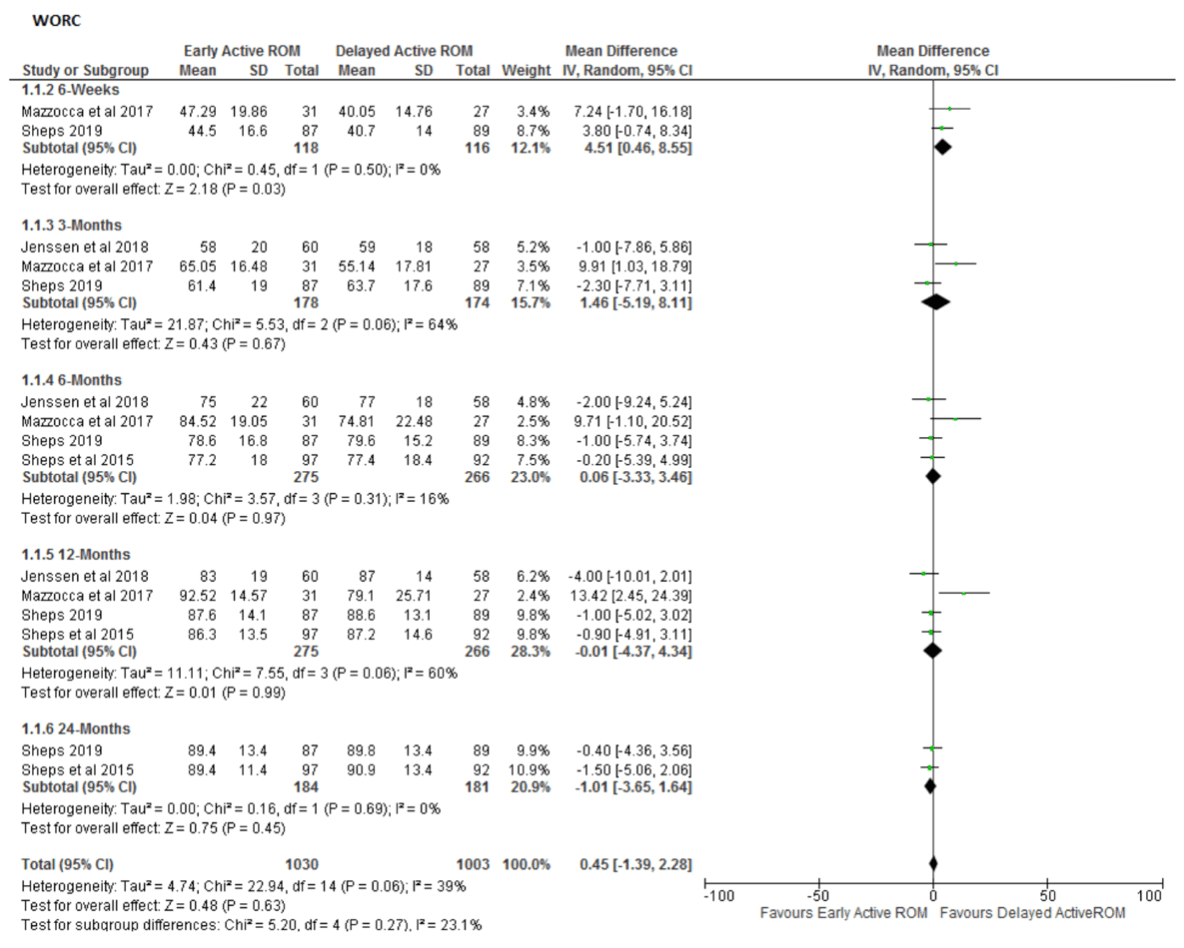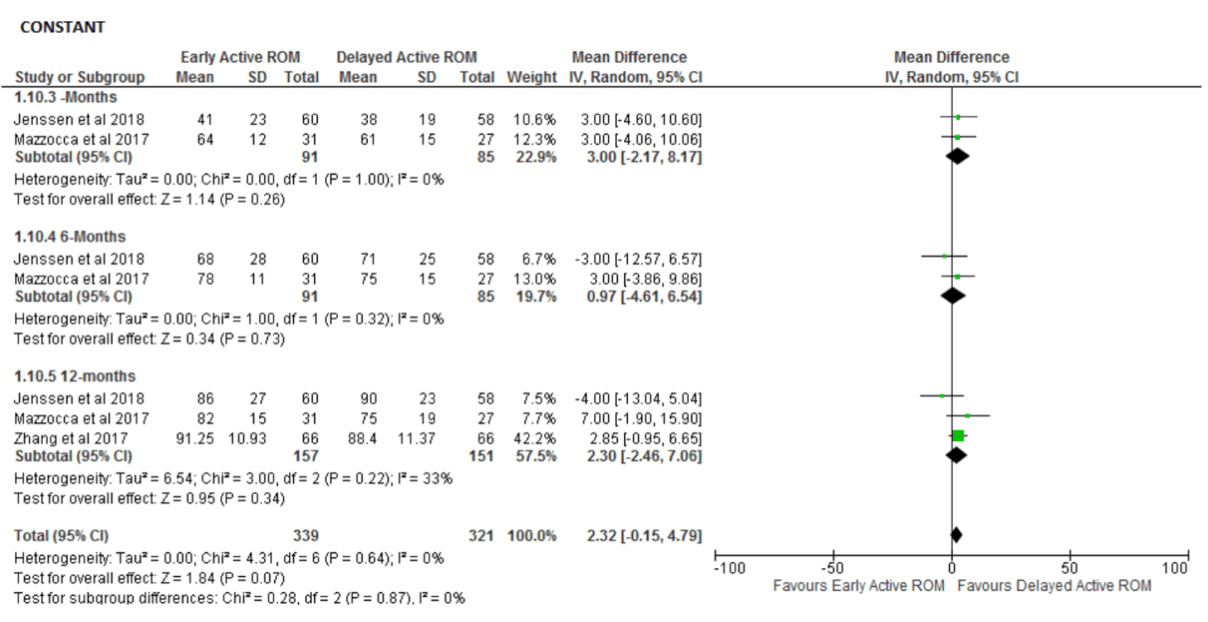The Effect of Early Active Movement on Clinical Outcomes Following Rotator Cuff Repair

Introduction
Rotator cuff pathology is a common source of shoulder pain and disability. When conservative management fails, surgery is advocated. Standard practice following rotator cuff tear repair is shoulder immobilization in a sling for up to 6 weeks. As no active movement is permitted, passive shoulder movements aim to minimize postoperative stiffness. However, a meta-analysis by Houck et al (2017) suggested that passive mobilizations may be related to increased retear rates. In this optic, active movement after rotator cuff repair may be an option but the effect of early active shoulder movement compared to immobilization following rotator cuff repair is not clear. Be sure to read on to find out!
Methods
A systematic review was conducted with prospective registration of the protocol. The GRADE framework was used to judge the certainty of evidence for main outcomes. A thorough search was conducted including studies comparing early active shoulder movement to delayed shoulder movement from 1990 on. Early movement was defined as active shoulder exercises in the first 6 weeks following surgery.
The outcomes of interest were clinical outcomes (pain, HRQoL, shoulder ROM, and shoulder strength), adverse events/complications, rotator cuff integrity, and return to work. The integrity of the rotator cuff repair at 12 months after surgical repair was expressed as a risk ratio (RR) with a 95 % CI based on the number of events (re-tears) per group
Pain was measured using a visual analog scale (VAS), and quality of life was assessed with the WORC Index where higher scores reflect worse outcomes. Function was expressed in the Constant Score where higher scores indicate better function.
Results
8 articles were included in the review and found no differences in pain, night pain and pain with activity scores between early or delayed movement over all time points. At 6 weeks, moderate quality evidence shows worse quality of life in the early active movement group, yet this difference was not clinically important and disappeared at following time points. Moderate quality indicates no differences with regard to function over all time points.

From: Silveira et al (2021)

From: Silveira et al (2021)
High quality evidence indicates that greater range of movement in active forward flexion and abduction was seen in the early active movement group at 6 weeks but this difference disappeared at the other time points. The same was true for external rotation, where the benefits extend to 3 and 6 months. The early movement did not result in differences in internal rotation or strength.
Study outcomes were consistent and there was moderate certainty evidence of no significant differences between groups regarding re-tear rates at 12 months after surgery. (RR=1.03, 95% CI (0.66, 1.61) p=0.90). None of the included studies reported return-to-work outcomes.

From: Silveira et al (2021)
Questions and thoughts
Data from eligible studies were pooled using a random effects model because of anticipated heterogeneity among studies. However, the included studies had similar populations (age, gender, surgical techniques) and consistent interventions, allowing meta-analysis, so the choice of using a random effects model to pool the interventions may be questionable.
An important thing to notice is that the included studies were underpowered to detect rotator cuff integrity. Despite the consistency in their findings of no harm associated with early active shoulder movement, this should be interpreted with caution.
Talk nerdy to me
The year 1990 was set as a limit, which could be a limitation. However, the authors reasoned it would better represent contemporary medical and rehabilitative practices after rotator cuff repairs and thus this date restriction does not appear to be a limitation. On the other hand, restricting included studies to English articles only is an important limitation as it could introduce publication and language bias.
Good aspects include the profound search, data extraction, and bias assessment by two independent reviewers. Sensitivity analyses were conducted in case findings were highly heterogeneous. Important to take into account is the fact that two studies were at high risk of selection bias, four studies were at high risk of performance bias and one study was at high risk of detection bias.
Take home messages
Although the clinical benefits are uncertain, early active shoulder movement appears safe with no significant difference detected in rotator cuff integrity between those who performed active shoulder movement and those who were immobilized in the first 6 weeks following rotator cuff repair. Very important to note is the fact that the study lacked the power to examine re-tears, which may have influenced the conclusion regarding this risk. Early in the recovery period, there was greater improvement in shoulder ROM for those who performed active shoulder movement. However, the differences were modest and likely not clinically important.
Reference
LEARN TO DISTINGUISH SHOULDER FACTS FROM FICTION
Awarded World Leading Shoulder Expert Filip Struyf takes you on a 5-Day Video Course to Bust Lots of Shoulder Myths that Prevent you From Delivering the Best Care for your patients with Shoulder Pain



